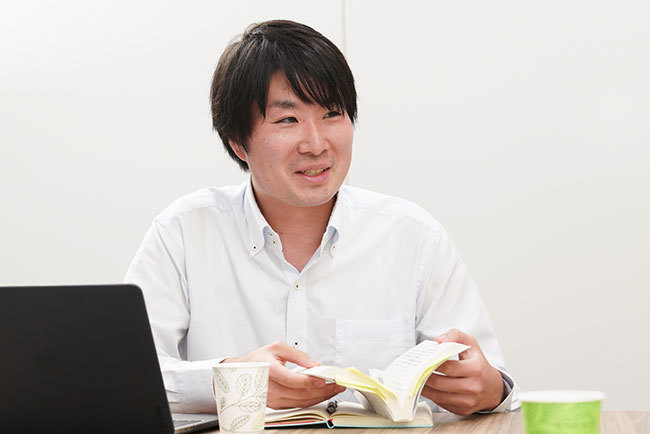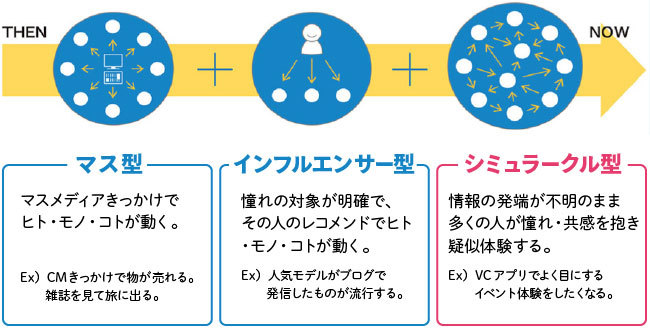Last October, Akira Amano of Dentsu Inc. Media Innovation Lab published his book "The Psychology of Sharing: Seven Perspectives for Understanding the SNS Information Environment" (published by Sendenkaigi).
This series delves deeper into the discussions presented in the book. For this installment, we welcome Mr. Takahiro Saegusa from Dentsu Inc. Isobar as our guest. Mr. Saegusa is highly knowledgeable about the "Psychology of Sharing," with expertise in viral content strategies and digital solution development. We will explore the future of communication strategies based on Mr. Saegusa's proposed concept of "Social Experience Design"!

From left: Mr. Takahiro Saegusa, Dentsu Inc. Isobar; Mr. Akira Amano, Dentsu Inc.
Designing user "experiences" through mechanisms that spark conversation
Amano: Mr. Saegusa, you handle branding and consulting that leverages SNS like Twitter and Facebook, and you've managed numerous projects deeply familiar with modern social media. First, could you explain the concept of "Social Experience Design" that you propose?
Mitsuhiro: I view social media not as a medium for information transmission like newspapers or television, but as a platform where you can observe people's actions and personalities.
When I want to disseminate information here, rather than creating one-way content, I focus on building mechanisms and contexts that foster conversations among users. I use the term "Social Experience Design" because it means designing the user experience—including conversation and sharing.
Amano: Today, the spread of information hinges not only on content's appeal or usefulness, but also on whether it creates mechanisms and contexts that make users want to share it. For example, the keyword "Make Conversation" gained attention at last year's Cannes Lions, right?
Mie: "Make Conversation," or essentially "chatting," has become a key concept in my own work too. Rather than one-way communication, I think it's ideal for companies to become entities that join in the conversation, or even if they don't directly participate, to provide topics that users find interesting enough to chat about among themselves.
As the volume of information circulating increases, I believe topics won't spread unless you create strong conversation seeds. However, once you create a strong conversation seed, users will naturally advance the conversation themselves. This leads to rapid information diffusion and the emergence of user-generated secondary content.
Amano: Conversely, this means we don't have to rely solely on the sender's power to "broadcast widely." I feel it's crucial to view leveraging the power of everyday people to spread the word as an opportunity.
Mie: To grasp such mechanisms and contexts, I believe it's vital to observe society thoroughly from both real-world and digital perspectives. This means not only analyzing online mentions using social listening tools but also observing offline trends. It's about listening to the broader social fabric of society, not just social media.
First, companies should thoroughly identify suitable themes for communicating with users, along with the spots where those topics are trending, and target demographics like age groups and locations. Then, they should introduce topics aligned with those findings.
Amano: In one case handled by Ms. Saegusa, they created unique (talk-worthy) goods related to the brand to generate buzz. This created touchpoints with the brand not just online, but offline too—meaning it wasn't confined solely to social media. This successfully led to a broad sharing of the experience.
What's interesting is that these initiatives gained traction overseas as well, becoming newsworthy because they were so engaging. It showed, "Look at the cool things happening in Japan!" A key point is that shares on social media can spread beyond the original intended audience. Creating this kind of positive "misdelivery" is a major benefit.
When users participate in a company's challenge (a set theme) and experience the communication there, the advertising campaign gains momentum. We see this happening in various places – good experiences spread.
Mitsue: What I found very interesting in Mr. Amano's book was the perspective of clarifying things from the "Why" point of view. In my daily work, I tend to think more about "What" and "How" a company communicates, but taking a step back to consider the "Why" perspective was very educational.
Also, the discussion of the simulacrum model, where trends emerge from a large number of users rather than from clear information dissemination by companies and influencers, was very interesting and overlapped with the measures we are proposing and implementing.
Amano: I'm very grateful to hear you say that. As with influencers and simulacra, there are highly sensitive people who actively disseminate information on the web and who, to a certain extent, create the atmosphere and trends in society. I think it is extremely important for people involved in advertising communication to focus on such people.
Perspectives on applying what you learned as a student to advertising work
Amano: Earlier, you mentioned that you conduct social listening both online and offline to capture user experiences such as conversations and shares. Could you tell us about what you do on a daily basis to observe users and the purpose of your observations?
Mie: To have meaningful conversations with users, I believe we need to understand what they typically talk about and how they live their daily lives. For instance, when planning a product for a certain company, I read several months' worth of magazines targeted at junior high and high school girls to understand the users—and it was quite eye-opening (laughs).
Amano: For junior high and high school girls! That's a world pretty far removed from us guys in our thirties now (laughs). What kind of insights did you gain from reading those magazines?
Mie: The language usage. It had a unique softness compared to the language used on owned media. For example, differences in emotional tone or the distinctive way Japanese characters are stylized when written.
Amano: Absolutely. Those finely granular insights are incredibly valuable. I believe there's a level of user understanding you can only reach by paying attention to the magazines and TV shows circulating among your users—by experiencing the information environment they inhabit.
Related to that, when we talk about "utilizing social media," the focus often shifts to information dissemination. But as we've discussed, I want to emphasize again that its true significance lies in using it to understand users.
Speaking of observation as a keyword, I hear you, Mr. Saegusa, did various things centered around observation even during your student days?
Mitsue: In university, I belonged to a fieldwork studies seminar, essentially a sociology seminar. There, we engaged in something called the "Power of Place Project." We would go to various locations, observe the behavior and demeanor of the people there, capture and analyze the essence of that "place" in our own way, and repeatedly output our findings. We did a lot of this to learn the very "method" of observation itself.
Amano: Learning observation itself sounds incredibly interesting. What kind of outputs did you produce specifically?
Mie: For example, we created calendars for the people in the towns we visited during fieldwork. These were personalized calendars plotting the birthdays of residents and commemorative dates related to the episodes we'd interviewed them about.
By deliberately positioning myself as an outsider, I could pick up on the town's strengths and the kindness of its people. It naturally forced me to view things from a bird's-eye perspective, and I think that's where my observational skills and ability to see were honed.
Amano: Half of my own work involves observing users. The core of research is uncovering and articulating the hidden insights of people using web services or smartphone apps.
The answers lie within the users, yet they themselves are unaware of them—that's precisely why I see our mission as prototyping multiple hypotheses to reach those answers.
Next, we should focus on (AI-driven) personalized experiences.
Mie: Thinking about the keyword "observation," something I personally find interesting lately is the audio media platform "Voicy." If the element of "audio" becomes increasingly used in social spaces going forward, I think that could become a new subject for observation.
Amano: I see. Unlike text, which can lose emotional nuance and phrasing, audio carries that data. In that sense, it's rich data.
Mie: Exactly. The idea that observing audio could lead to new services and communication really piques my curiosity (laughs). We're also developing applications for smart speakers at our company.
Amano: When new services and technologies like this emerge, observation from the user's perspective—not just the developer's—becomes incredibly important. For example, everyone knows how to use a TV, but people might not actually understand how to use a smart speaker yet.
To be more precise, such "usage" is constantly being redefined within users' actual practices. How can we leverage technology that brings new experiences for marketing? Isn't this precisely an unexplored territory for planners and researchers?
Mie: It's not just about creating new technology and stopping there. Precisely because it's a new service, we must carefully consider how to collect data and conduct observations.
Amano: Speaking of new technology, I found Dentsu Inc. Isobar's 2018 report "Augmented Humanity" fascinating. It explored how user experiences will be increasingly expanded by technology. Could you share your key takeaways?
Mitsue: There were several keywords, but "The Economy of Me" was the most interesting and feels closely related to our current discussion. This concept involves providing more personalized services, such as recommending products or places that reflect an individual's preferences and personality.
For example, in a project Dentsu Inc. Isobar worked on for Hokkaido's airline AIRDO, they developed a service using LINE Business Connect. This service notifies users about their flight ticket reservations and payment status, and delivers Hokkaido tourism information tailored to each individual.
Currently, much of what's available still feels like impersonal communication, clearly generated by programs. However, I believe that with the power of technologies like Adobe Sensei AI, we'll be able to provide more personalized, hospitable experiences in the future.
Amano: Personally, when considering future user experiences, I see great potential in providing personalized experiences through AI. This could be realized through voice communication with smart speakers or delivered on platforms like messenger services.
In that sense, communication will likely become even more one-to-one and chat-like, and "conversation" in this context should hold significant meaning when considering future experiences.
Thank you very much for this valuable dialogue!











